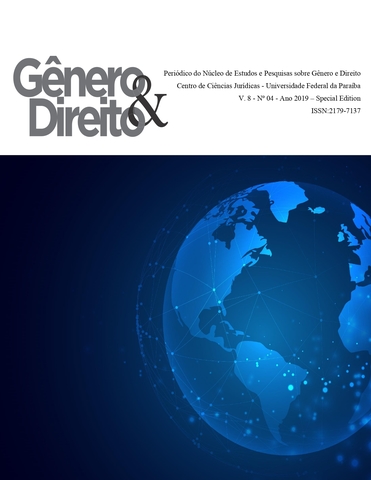MODAL WORDS OF POSSIBILITY IN THE TRANSLATION FROM RUSSIAN INTO CHINESE: HULL-ORIENTED ANALYSIS
DOI:
https://doi.org/10.22478/ufpb.2179-7137.2019v8n4.48427Palavras-chave:
modal words with the meaning of possibility, correspondence, Russian, Chinese, linguistic corpus, translation.Resumo
The article deals with the modal words with the meaning of the possibility in the translation aspect from Russian to Chinese. The attention is focused on the ways of possibility modality expression in the linguistic corps of the languages being studied. The relevance of this work is determined by the fact that it relies on a contrastive description of the linguistic facts of Russian and Chinese languages and is carried out in line with the modern comparative-typological approach to the study of modal words with the meaning of possibility. The article attempts to study the modal words with the meaning of possibility in the framework of Russian-Chinese translation. In order to determine the features of possibility modality translation, the following studies were carried out: 1) the modal words with the possibility value were divided into four types; 2) the search was performed for the correspondence of words and word combinations in a parallel corpus. The scientific work also presented an experimental study, which allows us to conclude that each type of modal words shows different conformity trends in translation: zero correspondence, correspondence and compensation. The quantitative analysis shows that the Russian-Chinese translation of modal words shows the tendency to full correspondence in a greater extent, which is primarily conditioned by similar semantic relations (the reflection of an utterance logical evaluation), expressed by modal words in both studied languages. It should be noted that such factors as the diachronic feature of the Chinese language, stylistics, the acceptance and the non-acceptance of Russian language features influence the translation of modal words with the meaning of possibility from Russian to ChineseDownloads
Referências
Traugott, E. & Dasher, R. 2002. Regularity in Semantic Change. New York: Cambridge University Press.
Papafragou, A. 2000. Modality: Issues in the Semantics-Pragmatics Interface. Amsterdam: Elsevier.
Palmer, F. 2001. Mood and Modality (2nd edition). Cambridge: Cambridge University Press.
Langacker, R. 1991. Foundations of Cognitive Grammar (Vol. 2). Stanford: Stanford University Press.
Givon, T. 1995. Functionalism and Grammar. Amsterdam / Philadelphia: Benjamins.
Hopper, P.J. & Thompson, S.A. 1984. The discourse basis for lexical categories in universal grammar. Language, 60(4). Рр. 703-752.
B.F. Lomaev. Modality of Possibility in Logic and Language // Young Scientist. - 2014. - №3. - pp. 834-837. — URL https://moluch.ru/archive/62/9466/ (reference date: 02.05.2018).
Zolotova G.A. Communicative grammar of Russian language / G.А. Zolotova, N.K. Onipenko, M.Yu. Sidorova. - Moscow: Institute of Russian language named after V.V. Vinogradov, RAS, 2004. - 544 p.
Peng Lizhen. 2005. Research modality of the modern Chinese language. Diss. for the scientific degree of Doctor of sciences. Fundan University. 2004. №1.
Liu Shuxiang. 1982. Fundamentals of Chinese language grammar. Beijing: "Shanu" publishing house.
Li Jinxi. 1992. New grammar of Chinese language. Beijing: “Shanu” publishing house.
Zhu Desi. 1982. Guide to Chinese language grammar. Beijing: "Shanu" publishing house.
Chen Guanglai. 1980. The study of functional words. Bulletin of Fudan University (collection of linguistics). (1). pp. 40-51.
Alyokhina T.A., Shchuklina T. Yu., MardievaL.A. Teaching Russian composites: normative and derivative aspects (on the material of compound adjectives in the Russian language) // Modern Journal of Language Teaching Methods.-2016.-Special Issue. - Pp. 207-211
Yusupova Z. F., You Lu, The theory and practice of studying pronouns by chinese students-philologists // Yazyk i kultura - Language and culture. - 2017. - Vol., Is.39. - P.75-83.
Kryukova N.I, Zakharova A.N, Dulina G.S, Yusupova Z.F. Didactic features of pedagogical interaction as the basis of university education // Man in India. - 2017. - Vol.97, Is.3. - P.29-41.
Erofeeva I.V., Adjective in the linguistic world-image of Russian medieval period (On the material of chronicles)//XLinguae. - 2017. - Vol.10, Is.3. - P.237-245.
Zakharov V. P. & Tao Y., 2015. The Development and Use of Russian-Chinese Parallel Corpus. Automatic Documentation аnd Mathematical Linguistics. Vol. 49 No. 2
Xie Kun. 2014. The study of modal predicates of Russian and Chinese languages from a logical and semantic aspect - "мочь (смочь)" and the Chinese word "neng" in practice. Bulletin of Foreign Languages under the PRC Army. (6): 124-131.
Zhang Huysen. 2001. Comparative analysis of Russian and Chinese languages (part 1). Shanghai: The publishing house "Shanghai Foreign Language Training"

